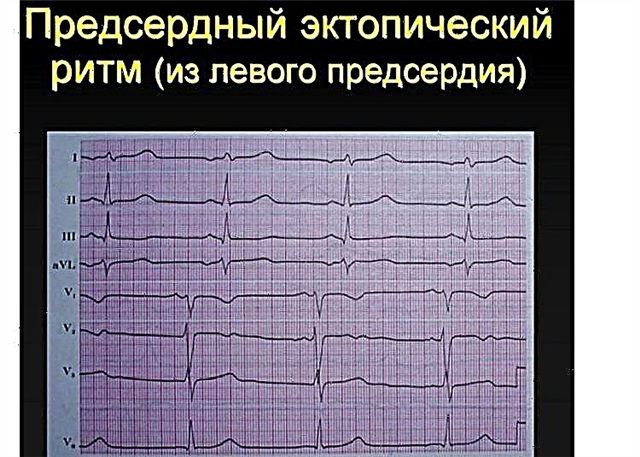Atrial fibrillation, or atrial fibrillation (AF), is an absolute form of arrhythmia (deviation from sinus rhythm). The sinus node completely loses the function of the main pacemaker, and very frequent (350-700 per minute) chaotic waves of excitation and contraction of individual muscle fibers appear in the atria (ectopic foci of excitation appear). Most of the generated impulses do not reach the ventricles, only a small part causes an irregular contraction of the ventricles.
The causes of MA paroxysms are many: background diseases of the cardiovascular system (ischemic heart disease, hypertension, cardiomyopathy, etc.), hyperproduction of thyroid hormones, menopause in women, drug overdose (diuretics, atropine, adrenaline), alcohol, caffeine abuse , electrolyte imbalance, psycho-emotional stress.
Patients with atrial fibrillation complain of rapid heartbeat, shortness of breath, dizziness, chest discomfort. Clinically, an arrhythmic pulse is determined in a person.
Patients with MA receive complex drug therapy: "Aspirin" for a long time, indirect anticoagulants under INR control ("Warfarin", "Pradaxa"), antiarrhythmic drugs (beta-blockers, "Amiodarone"), "Digoxin". If ineffective - electric pulse therapy, implantation of a pacemaker, catheter ablation of the excitation focus.
What are the features of the diet for atrial fibrillation?
For all patients, regardless of age and the cause of AF, a special diet based on the predominance of plant foods and low-fat foods in the diet is included in the complex therapy.
In terms of energy value, the distribution of basic nutrients and the restriction of certain foods, the diet for arrhythmia is as close as possible to the table number 10 according to Pevzner.
Basic rules for catering:
- frequent fractional food intake (four to six times a day). When overeating, the swollen stomach and intestines props up the diaphragm, stimulates the roots of the vagus nerve and provokes paroxysmal MA. Eliminate the consumption of foods that contribute to gas formation (legumes, cabbage, whole milk);
- the temperature of the consumed should not be extremely cold or hot;
- give preference to steamed, boiled, stewed, baked dishes;
- it is not recommended to salt food during cooking. Salting at the table helps control overall salt intake;
- limiting table salt to six grams (teaspoon);
- control of fluid intake;
- an increase in the menu of foods rich in potassium, magnesium, calcium, phosphorus;
- an increase in fiber consumption, a decrease in meals with a high level of unsaturated fatty acids;
- the energy value of the diet is 2600-2800 kcal. The share of carbohydrates 350-400 g, proteins 90-100 g, fats 80 g;
- reducing the daily dose of sugar to 50 grams;
- restriction of fluid to 1.5 l / day.
Patients taking "Warfarin" should pay special attention to the control of vitamin K intake (see the table below for more details). "Warfarin" is an indirect anticoagulant that acts on clotting through vitamin K. An excess of this vitamin reduces the effect of "Warfarin" and causes blood clots. The daily amount should not exceed 105 mcg / day. The maximum concentration of vitamin K is found in leafy vegetables, green tea, and cabbage. Also, do not take multivitamins without a doctor's prescription. Excessive consumption of cranberries enhances the effect of "Warfarin"
List of prohibited foods
A diet with atrial fibrillation excludes the following foods:
- Caffeinated drinks - strong coffee, tea (excessive stimulation of the heart).
- Smoked sausages, bacon (excess animal fats, salt).
- Pickles, pickled foods, canned food (excess salt, provocation of additional fluid intake).
- Fatty meats and offal (excess cholesterol and calories).
- Whole fat dairy products.
- Butter and creamy pastries, white chocolate (refractory fats, excess sugar).
- Semi-finished products, unhealthy fast food (contribute to weight gain).
- Hot sauces, spices, seasonings (reflexively stimulate the heart).
- Alcohol (causes spasm of the coronary arteries, impairs myocardial nutrition).
Recommended food items menu
A special diet includes foods useful for the heart in case of arrhythmias and is based on the provision of important micronutrients for the nutrition of the heart muscle (K, Ca, Mg).
Magnesium is found in wheat bran, cocoa, nuts, soybeans, brown rice, oatmeal, legumes, buckwheat, grain bread, hard cheese, and cucumbers.
There is enough potassium in sprouted grains, baked potatoes, bananas, beans, carrots, pumpkin, avocado, raisins, dried apricots, and prunes.
Calcium is found in milk, cottage cheese, hard cheese, nuts, beets, corn porridge, pumpkin seeds, and seafood.
List of permitted foods and dishes:
- bread made from wholemeal flour, bran, rye, grain. Long-lasting biscuits, uncomfortable savory pastries;
- lean meat, poultry (boiled, stewed or baked veal, chicken, turkey, rabbit);
- lean river fish, brown algae, coho salmon and baked mackerel are restricted;
- eggs up to three pieces a week, mostly boiled, as part of omelets and casseroles;
- low-fat dairy products, fermented milk cheese 5% fat, diet unsalted rennet cheese, sour cream 10% up to 2 tablespoons;
- oils - give priority to vegetable, use for cooking, dressing salads (sunflower, olive, linseed, corn);
- boiled, crumbly cereals, casseroles; pasta only from durum wheat; beans, lentils, boiled peas;
- vegetables in large quantities, prepared in various ways, fresh in salads. Olive oil is used as a dressing. It is recommended to add parsley, dill;
- seasonal fruits and berries (out of season - dried fruits), compotes;
- sauces based on milk, tomatoes, berries;
- from drinks - light herbal tea, chicory with milk, diluted juices (mainly from vegetables), compotes, rosehip decoction.
Approximately 60% of the total diet are vegetables and fruits, 25% are carbohydrate foods and 15% are protein foods.
Conclusions
Diseases of the cardiovascular system rank first in the ranking of causes of death in developed countries. Today, atrial fibrillation, along with extrasystole, is increasingly being determined in young people. The chances of getting irregular heart rhythms are increased by physical inactivity, obesity, smoking, alcoholism, and hereditary family history.
Nutrition for atrial fibrillation should fully meet the energy needs of the body and be varied, complete, balanced. Obese patients are advised to reduce the daily calorie intake to 2500 kcal. Rational nutrition and systematic intake of antiarrhythmic drugs makes it possible to reduce the overall cardiac risk, reduce the frequency of paroxysms and ease the course of the disease.



